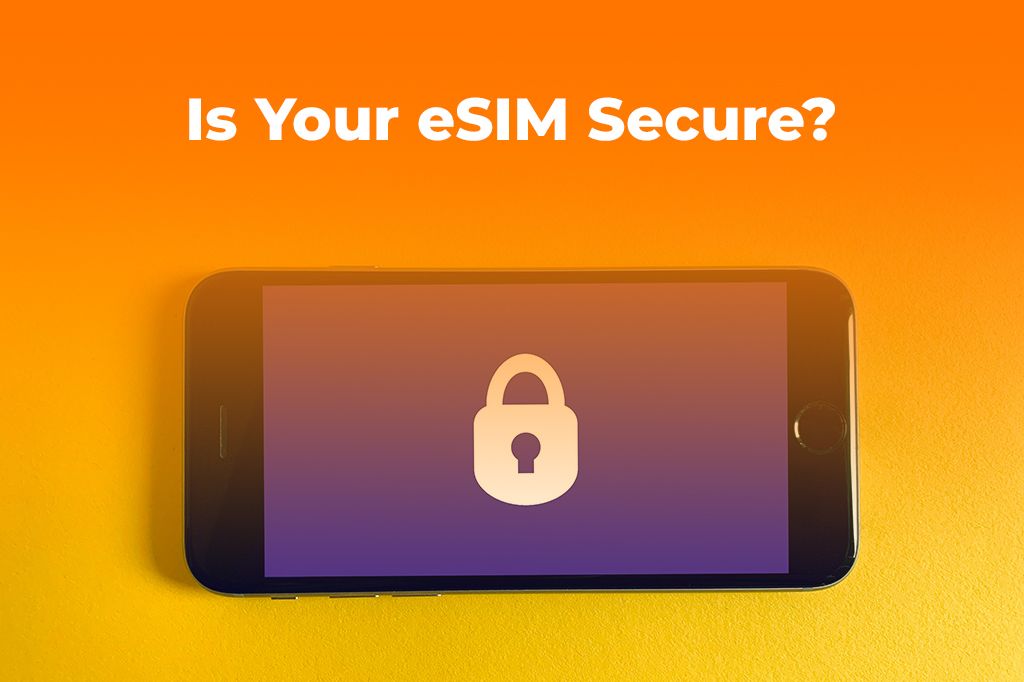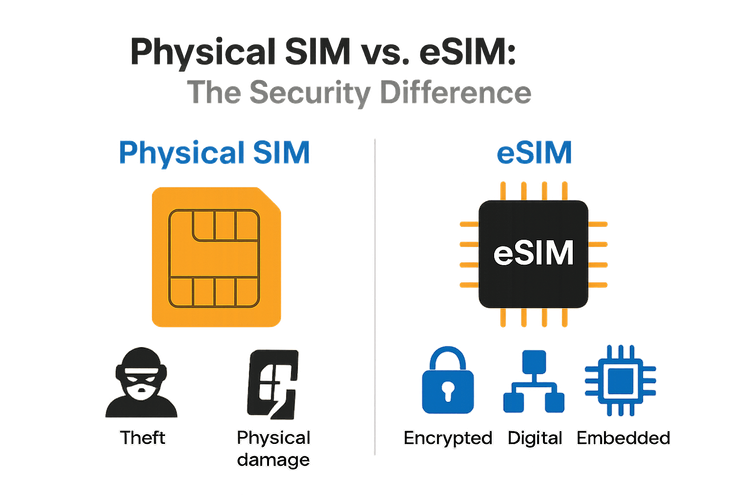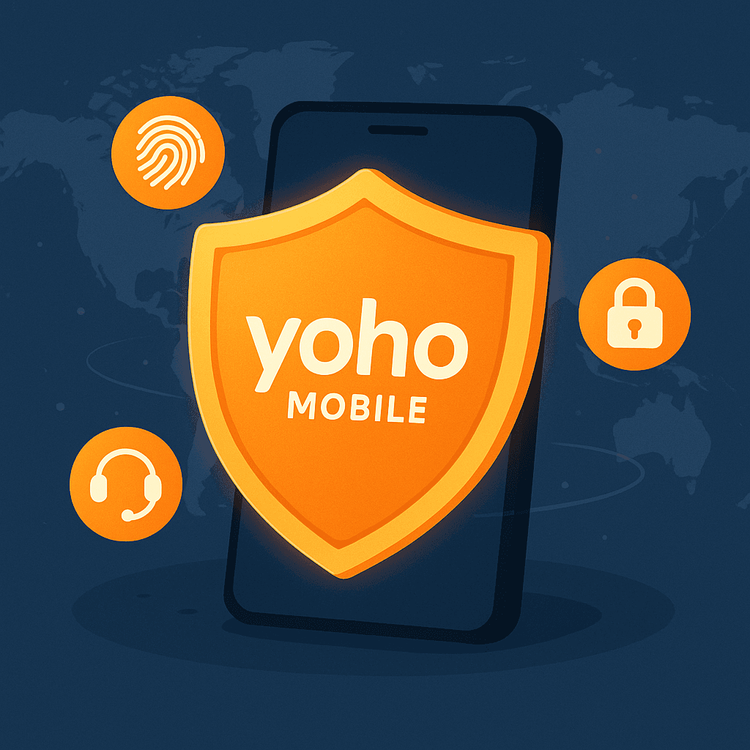eSIM technology has revolutionized how we connect, offering unparalleled convenience for travelers and digital nomads. The ability to activate a data plan with a few taps, without fumbling with tiny plastic cards, is a game-changer. But with this digital leap comes an important question: Is your eSIM secure?
The short answer is yes, eSIMs are inherently very secure. However, like any digital technology, the risks often lie not in the tech itself, but in how it’s managed. In this guide, we’ll break down the potential eSIM security risks, like the notorious SIM swapping attack, and explain the concrete steps Yoho Mobile takes to keep your connection safe and sound.
Ready to explore the world without connectivity worries? Check out Yoho Mobile’s secure and flexible eSIM plans today!

What Are the Main eSIM Security Risks?
An eSIM, or embedded SIM, is a chip soldered directly onto your phone’s motherboard. This physical integration makes it much harder to steal or damage than a traditional SIM card. The primary threats to your eSIM’s security are digital and often involve tricking you or your provider, rather than hacking the chip itself.
SIM Swapping Attacks: A Digital Threat
SIM swapping is a type of identity theft where a scammer convinces your mobile provider to transfer your phone number to a new SIM card—or in this case, a new eSIM—that they control. Once they have your number, they can intercept calls, messages, and most critically, the two-factor authentication (2FA) codes sent to your phone. This can give them access to your bank accounts, email, and social media.
While this threat exists for both physical and digital SIMs, the method is the same: social engineering. The attacker gathers personal information about you (often from data breaches or social media) and uses it to impersonate you when talking to a carrier’s support staff. For more on related threats, you can read about what SIM cloning is.
Phishing and Malicious QR Codes
Another risk involves phishing. A scammer might send you an email or text that looks like it’s from a legitimate mobile provider, urging you to scan a QR code to ‘update’ or ‘reactivate’ your service. This malicious QR code could install a fraudulent eSIM profile on your device, potentially rerouting your data through insecure servers or giving attackers control.
This is why it’s crucial to only ever use QR codes or installation methods from your trusted provider’s official website or app.

How Yoho Mobile Prioritizes Your eSIM Security
At Yoho Mobile, we understand that peace of mind is non-negotiable. We’ve built our platform with multiple layers of security to protect you from these very risks, ensuring your secure travel connectivity is our top priority.
Robust Account Verification
To prevent unauthorized access and SIM swapping attempts, Yoho Mobile employs strong identity verification processes. Before any significant changes can be made to an account, we ensure the person making the request is truly you. This customer-centric approach is a critical line of defense against social engineering attacks. You can learn more about the importance of electronic verification by reading our post on eKYC meaning.
Secure, Direct-to-Device Installation for iOS
We’ve streamlined the process to enhance security. For iOS users, Yoho Mobile offers a major advantage: you don’t need to scan a QR code. After purchase, you simply tap the ‘Install’ button directly within our app or website. Your phone’s operating system handles the rest, installing the eSIM profile in under a minute. This closed-loop system eliminates the risk of a malicious QR code being intercepted or used.
Android users are also protected through a secure process managed within the official Yoho Mobile app.
Proactive Support and Yoho Care
If you lose your device or suspect any unusual activity, our 24/7 customer support is ready to help you secure your account immediately. Furthermore, we offer a unique safety net with Yoho Care. If you unexpectedly run out of high-speed data, Yoho Care provides a backup connection to ensure you’re never left completely offline and vulnerable in an unfamiliar place. It’s security and connectivity, guaranteed.

Practical Steps to Protect Your eSIM Account
While Yoho Mobile works to protect you on our end, good digital hygiene is your best personal defense. Here are some actionable steps you can take:
- Use a Strong, Unique Password: Create a complex password for your Yoho Mobile account that you don’t use anywhere else. Authoritative bodies like the National Institute of Standards and Technology (NIST) provide excellent guidelines for password security.
- Beware of Phishing: Be skeptical of unsolicited emails or texts asking for personal information or urging you to scan a QR code. Verify any requests by logging into your account directly through the official app or website.
- Enable 2FA on Your Email: Secure the email account associated with your Yoho Mobile profile with two-factor authentication. This adds a crucial security layer.
- Check Device Compatibility: Before traveling, ensure your phone is on our official eSIM compatibility list to guarantee a smooth and secure setup.
- Travel Smart: When preparing for your trip to a destination like Japan or the United States, securing your digital life is as important as packing your bags. For more tips, see our guide on how to use public WiFi safely.
Frequently Asked Questions (FAQ)
Is an eSIM safer than a physical SIM card?
Yes, in many ways. An eSIM cannot be physically removed and stolen from your phone like a traditional SIM card. This makes it more secure against simple theft. The security risks are primarily digital, such as phishing and account takeovers, which can be mitigated with good security practices and a secure provider like Yoho Mobile.
Can my eSIM be hacked or cloned?
The eSIM chip itself is highly encrypted and extremely difficult to hack or clone directly, a topic explored in depth by industry experts at outlets like WIRED. The term ‘hacking’ in this context usually refers to an attacker gaining control of your phone number through SIM swapping, not by breaking the eSIM’s encryption.
What should I do if I lose my phone with an active Yoho Mobile eSIM?
If you lose your phone, contact Yoho Mobile support immediately. We can help you deactivate the eSIM profile on the lost device and assist you in transferring your plan to a new device once you have one. This ensures no one can use your data plan.
How does SIM swapping with an eSIM work, and how can I prevent it?
SIM swapping with an eSIM works the same way as with a physical SIM: an attacker uses your personal data to trick your mobile provider into transferring your service to a device they control. You can prevent this by using strong passwords, being wary of phishing scams, and choosing a provider like Yoho Mobile that has strong account verification procedures.
Conclusion
eSIMs represent the future of connectivity—they are flexible, convenient, and built with modern security standards in mind. While risks like SIM swapping and phishing exist, they are not unique to eSIMs and can be effectively managed.
By understanding the threats and taking simple preventative measures, you can enjoy all the benefits of eSIM technology with confidence. Yoho Mobile reinforces your security with robust verification, secure installation methods, and dedicated support, letting you focus on your journey, not your connection.
Ready to travel with the peace of mind that comes with secure, reliable connectivity? Explore Yoho Mobile’s eSIM plans and join the future of travel today.
